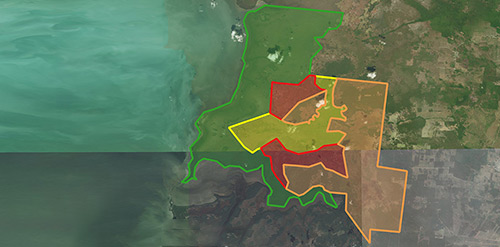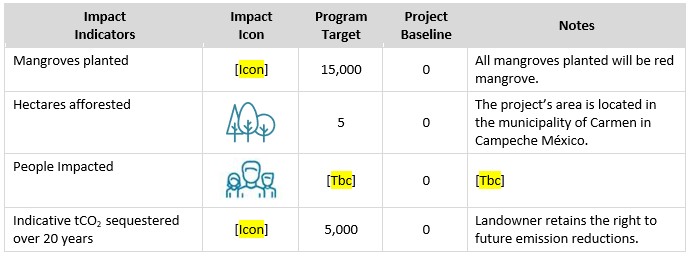Los Petenes Project Overview
The blue carbon project, El Diamanté Azul de Los Petenes Biosphere Reserve, a Mangrove Conservation and Restoration Project, is approximately 15 thousand hectares in size and growing. It is located in the Petenes Biosphere Reserve (RBLP), in the state of Campeche, Mexico. RBLP forms and ecoregion involving other coastal protected natural areas that include Biosphere Reserve Ria Celestun and the Yucatán’s Biosphere Reserve El Palmar.
This entire area is of great importance to the biodiversity of Mexico, not only because of its high diversity of flora and fauna but also because it provides food, water and protection to so many species that live in the reserves both permanently and temporarily. The avifauna is of particular importance because the area contains 193 species of birds, both resident and migratory, of which 65 are in some category of protected status as indicated in the Ecological Standard-059. In addition, the area is habitat for endangered wild mammals such as the jaguar (Panthera onca), the ocelot (Leopardus pardalis), the tigrillo (Leopardus wiedii) and the spider monkey (Ateles geoffroy).
Mangroves occupy approximately 50% of the land area of the RBLP. Its main components are the red mangrove (Rhizophora mangle), black mangrove (Avicennia Germinans), white mangrove (Laguncularia racemosa) and buttonwood (Conocarpus Erectus) which are mostly made up of fringe mangrove (21,869.7 ha) and chaparro mangrove (13,829.5 ha). These mangroves are currently under threat and strong pressure from timber extraction, agriculture, livestock and urban growth in the periphery of the RBLP. The RBLP is also under the influence of at least 14 Ejidos (government sponsored communal property owners) from the different surrounding municipalities. One of the most damaging activities from these organizations (ejidos) has been the fragmentation produced by the construction of roads.
The project’s conservation and restoration activities will be conducted entirely by local community members and will be trained by an experienced local cooperative managed 100% by women. The project leadership will include local community members as well as financial benefit streams will flow directly to local community families. Local community participation in the restoration and reforestation of 4,616 hectares of degraded mangrove area will provide incentive for the locals to preserve and protect the mangroves. In addition to the direct employment, the environmental services provided by the ecosystem once recovered will include increased quality of habitat for fish and birds, improved water quality, as well as sequestration of more than 14 million tCO2e over the life of the project. From the 10,400 Ha of pristine mangroves, another 4.7 million tCO2e in avoided emissions will be prevented due to the conservation activities over the life of the project.
The project currently achieves sustainable development goals 1, 2, 5, 8, 11, 13, 14 and 15 and as the social impact programs are rolled out and operating; we believe the project will achieve all 17 sustainable development goals. The project will provide social impact programs to almost 15,000 community members living in and around the project area that includes Tenabo with a population of 11,284, San Francisco Kobé with a population of 1,945, and Hampolol with a population of 1,223. The community development programs will include but are not limited to providing medical and dental assistance, education programs that include classroom upgrades and computers, supporting and building local libraries, trash recycling programs, agroecology, and supporting microbusiness enterprise such as sustainable cattle ranching programs, sustainable fishing programs, apiculture or honey production, eco-tourism, sports fishing for tourists (catch and release), and many more programs.
Project Area Highlights:
- 14,883 Ha Mangrove
- 11,883 Ha Conservation
- 3,000 Ha Restoration
- 2,150,000 tCO2 Avoided
- 6,035,000 tCO2 Sequestered

KML File available for download
[real3dflipbook id=’20’]
Project Supplemental Information
(Click to start the presentation)
Sustainable Development Goals (SDGs) and Impacts
For a full list and explanation of each SDG, click here
Project Impacts and Outcomes

Implementation Timeline
To Be Determined
Related Imagery and Resources
Ongoing Field Worklog Notes
B1-2019 Ground-truth and site visit
Lorem ipsum dolor sit amet lectus quisque taciti ultrices ornare nec mauris tellus nullam platea ante consectetur placerat nam malesuada erat iaculis sapien magna morbi tempus tortor volutpat fringilla pretium porta hac libero pulvinar eleifend ex feugiat pharetra laoreet eu tristique luctus maecenas fusce volutpat finibus vestibulum eros viverra amet
